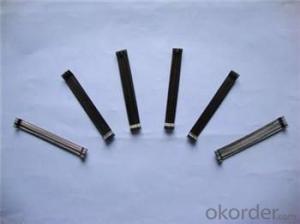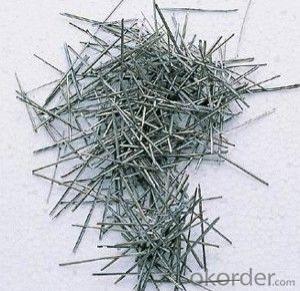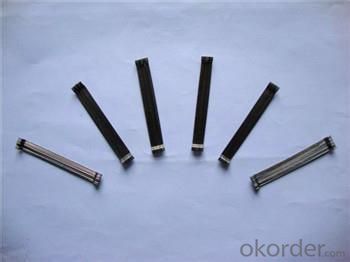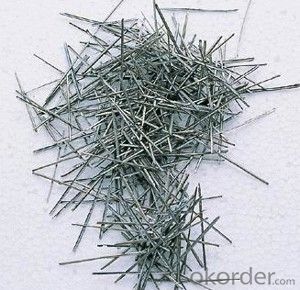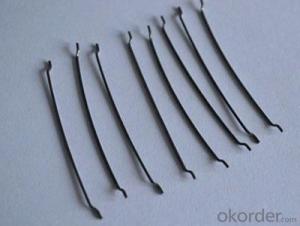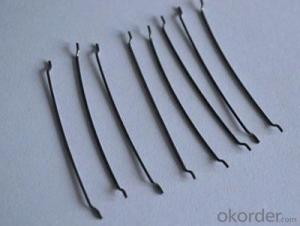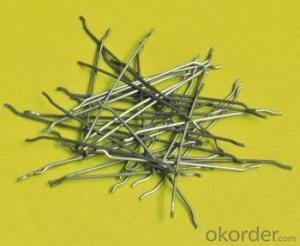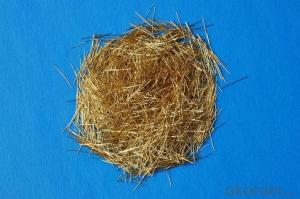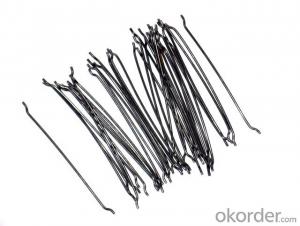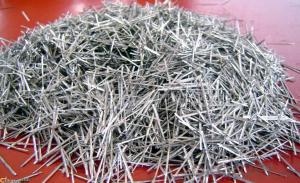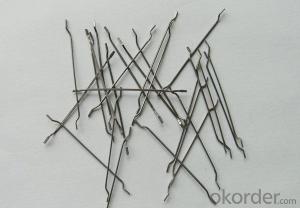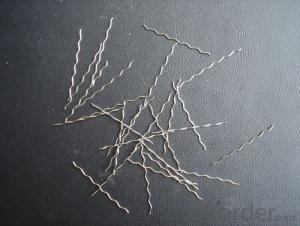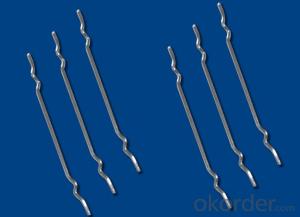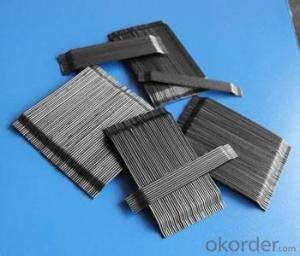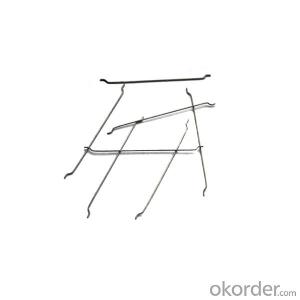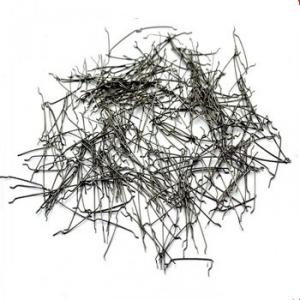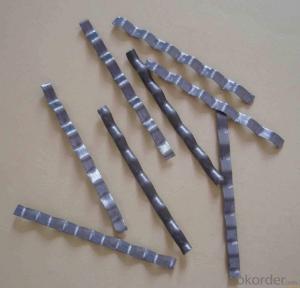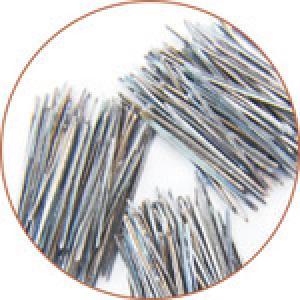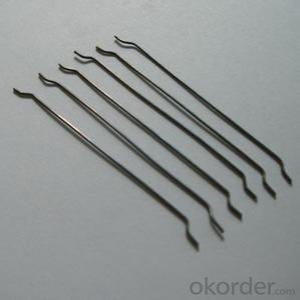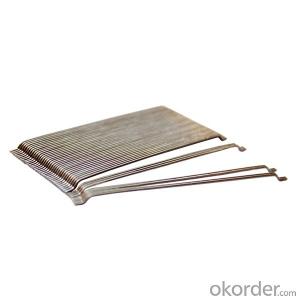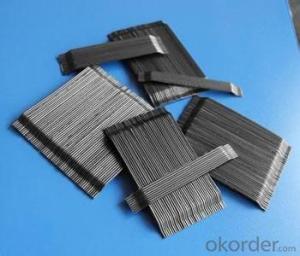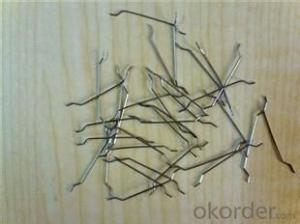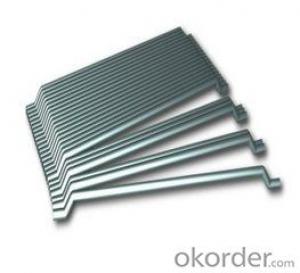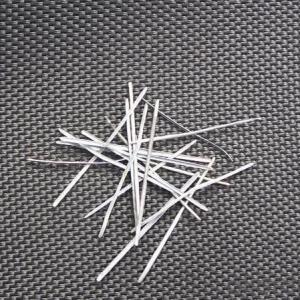Melt Extract Stainless Steel Fiber for Construction and Concrete
- Loading Port:
- Tianjin
- Payment Terms:
- TT OR LC
- Min Order Qty:
- 5000 kg
- Supply Capability:
- 250000 kg/month
OKorder Service Pledge
OKorder Financial Service
You Might Also Like
Quick Details
type: steel fiber
usege: concrete of construction
material: steel wire
shape: hooked end,straight middle round fiber
appearance: clear and bright
Place of Origin: Shandong, China (Mainland)
- Model Number: hooked steel fiber
Product features
steel fiber for conatruction and concrete reinforcement,widely uesd in concrete to improve its stabality
end hooked steel fiber ,with its high tensile strength ,good scattering and good combination with cenment material
concrete steel fiber is specifically designed to enhance concrete in its hardened state ,the uniform distribution of steel fibers throughout the concrete greatly improve concrete bonding and tensile strengh ,addtionally it provides eceptional load stability and durability ,as reliable and efficient concrete reinforement materisl ,it is widely used in buildings ,bridges,thin roof engineering ,highy way etc.
Specifications
Length :20-60mm
Diameter :0.5-1.2mm
tensile strength :>1100Mpa
type :hooked end ,straight round fiber
appearance : clear and bright
Picture
WAVE STEEL FIBER
HOOK-END STEEL FIBER
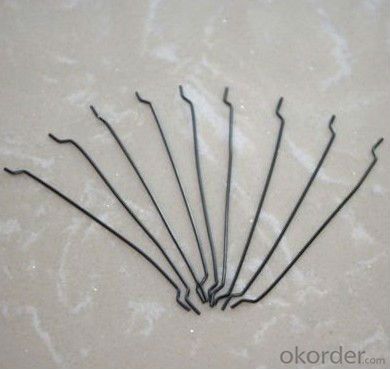
GLUED STEEL FIBER
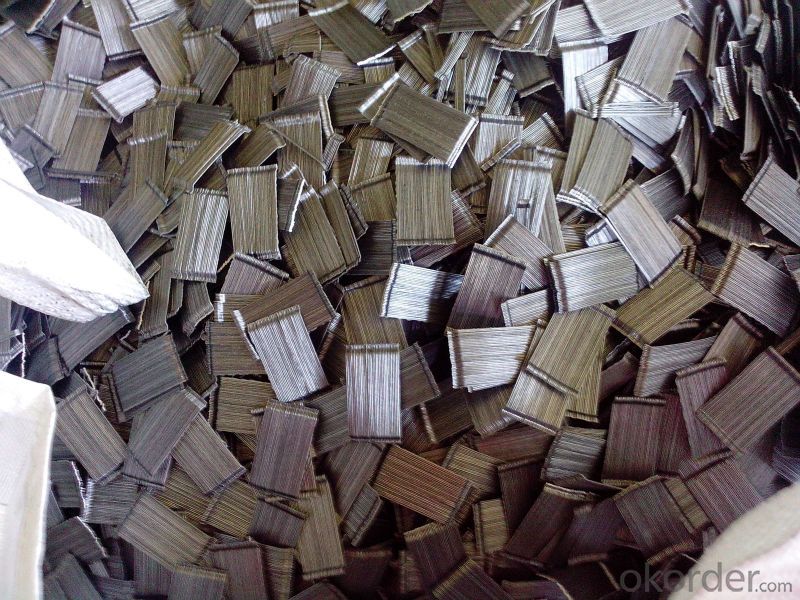
FAQ
we can produce any type steel fiber and of course we can make production according to your requirement
we have specilize in this field for almost 10 years ,with good quality and competitive price
- Q: How does melt extract stainless steel fiber improve the resistance to fatigue in shotcrete?
- The resistance to fatigue in shotcrete is enhanced by melt extract stainless steel fiber, which adds extra reinforcement to the concrete matrix. Shotcrete, commonly used in construction projects that require high strength and durability, is prone to fatigue and cracking due to repeated loading and cyclic stresses. By including melt extract stainless steel fibers in the shotcrete mix, the overall fatigue resistance of the material is significantly improved. These fibers act as discrete reinforcement, distributing the applied stresses more evenly throughout the concrete. This helps prevent the formation and spreading of cracks, thereby enhancing the overall durability and lifespan of the shotcrete structure. The effectiveness of melt extract stainless steel fibers in enhancing fatigue resistance is due to their unique properties. These fibers are made from high-quality stainless steel, which possesses excellent tensile strength and corrosion resistance. Additionally, the manufacturing process ensures that the fibers have a smooth surface and uniform geometry, allowing for better bonding with the concrete matrix. Moreover, the addition of melt extract stainless steel fibers can also enhance the flexural strength of shotcrete, making it more resistant to bending and flexing stresses. This is particularly crucial in applications such as tunnel linings, underground structures, and retaining walls, where shotcrete is subjected to significant cyclic loading. To summarize, melt extract stainless steel fiber improves the resistance to fatigue in shotcrete by providing additional reinforcement, distributing stresses more evenly, and reducing the formation and propagation of cracks. As a result, shotcrete structures become more durable and long-lasting, capable of withstanding cyclic loading and maintaining their structural integrity over time.
- Q: Can melt extract stainless steel fiber reduce the risk of spalling in high-strength concrete?
- Yes, melt extract stainless steel fiber can reduce the risk of spalling in high-strength concrete. Stainless steel fibers improve the tensile strength, ductility, and overall durability of concrete. When added to high-strength concrete, these fibers help to control cracking and minimize the potential for spalling, especially under severe loading conditions or in high-temperature environments.
- Q: What is the effect of melt extract stainless steel fiber on the fatigue life of asphalt mixtures?
- Incorporating melt extract stainless steel fibers into asphalt mixtures yields positive outcomes for the material's fatigue life. The purpose of adding these fibers is to enhance the mechanical properties of the asphalt mixtures and enhance their performance in repeated loading scenarios. The inclusion of stainless steel fibers in asphalt mixtures aids in bolstering resistance to fatigue cracking. Fatigue cracking is a common issue in asphalt pavements, particularly in areas with heavy traffic, as continuous vehicle loading weakens the material and causes it to crack eventually. Through the integration of stainless steel fibers, the asphalt mixture becomes more resilient, allowing it to endure higher levels of stress without developing cracks. The stainless steel fibers serve as reinforcement within the asphalt matrix, lending additional strength and improving material cohesion. This reinforcement effectively distributes the load evenly across the pavement, reducing stress concentration in specific areas and minimizing the formation of fatigue cracks. Moreover, the presence of stainless steel fibers in the asphalt mixture enhances its resistance to permanent deformation or rutting. Rutting occurs when the asphalt material deforms and permanently shifts under repeated traffic loads. The fibers play a crucial role in stabilizing the asphalt matrix, thereby preventing excessive deformation and maintaining the structural integrity of the pavement. Overall, the incorporation of melt extract stainless steel fibers into asphalt mixtures significantly improves the material's fatigue life. It enhances resistance to fatigue cracking and rutting, resulting in longer-lasting and more durable asphalt pavements. This can lead to reduced maintenance and repair costs, as well as enhanced safety and comfort for road users.
- Q: Can melt extract stainless steel fiber be used in parking garage construction?
- Yes, melt extract stainless steel fiber can be used in parking garage construction. Stainless steel fibers are commonly used in concrete to improve its structural performance and durability. They can help enhance the tensile and flexural strength of the concrete, reduce cracking and shrinkage, and increase resistance to corrosion and abrasion. In parking garages, where heavy loads, vehicle traffic, and exposure to moisture and chemicals are common, the use of stainless steel fibers can significantly improve the longevity and performance of the concrete. Additionally, stainless steel fibers can also enhance the fire resistance of concrete, making them suitable for parking garages where fire safety is crucial. Overall, melt extract stainless steel fiber is a suitable and effective reinforcement material for parking garage construction.
- Q: Can melt extract stainless steel fiber be used in pre-stressed concrete applications?
- Yes, melt extract stainless steel fiber can be used in pre-stressed concrete applications. The high tensile strength and corrosion resistance of stainless steel fibers make them suitable for reinforcing concrete structures that are subjected to pre-stressing forces. These fibers can enhance the durability and structural integrity of pre-stressed concrete elements, providing additional strength and preventing cracking or failure under tension.
- Q: What is the difference between melt extract stainless steel fiber and other types of steel fibers?
- Melt extracted stainless steel fiber, also referred to as melt extract steel fiber, is produced by melting stainless steel and then swiftly drawing it into fine fibers. This manufacturing process yields fibers with distinct properties and characteristics compared to alternative steel fibers. An important distinction of melt extract stainless steel fiber from other varieties is its improved resistance to corrosion. Stainless steel is renowned for its capacity to withstand corrosion and oxidation, rendering melt extract stainless steel fibers highly impervious to rust and degradation over time. Consequently, they are suitable for use in environments prone to exposure to moisture, chemicals, or other corrosive substances. Another distinction lies in the heightened tensile strength of melt extract stainless steel fibers. The expedited extraction process aligns the steel molecules, resulting in fibers that are more robust and durable than their counterparts. This augmented tensile strength makes melt extract stainless steel fibers optimal for reinforcing concrete or other materials that necessitate high strength and durability. Additionally, melt extract stainless steel fibers exhibit exceptional thermal and electrical conductivity. This attribute makes them suitable for applications requiring efficient heat or electricity transfer. For instance, they can be employed in heating elements, electromagnetic shielding, or as conductive reinforcement in composites. Lastly, melt extract stainless steel fibers possess a smoother surface compared to other steel fibers. This smooth surface promotes improved bonding with the surrounding matrix, such as concrete or resin, leading to enhanced load transfer and overall performance. Furthermore, the smoothness reduces the likelihood of fiber pull-out or breakage, further enhancing their effectiveness as reinforcement materials. In conclusion, melt extract stainless steel fibers distinguish themselves from alternative steel fibers due to their enhanced corrosion resistance, increased tensile strength, exceptional thermal and electrical conductivity, and smoother surface. These distinctive properties render them a preferred choice for various applications requiring high-performance reinforcement materials.
- Q: Can melt extract stainless steel fiber reduce the risk of early-age cracking in concrete?
- The inclusion of melt extract stainless steel fibers in the concrete mix can effectively mitigate the occurrence of early-age cracking. Shrinkage, temperature fluctuations, and insufficient tensile strength are common factors contributing to such cracking. The addition of these fibers enhances the overall tensile strength of the concrete, acting as a reinforcement that effectively disperses stresses and hinders the initiation and spread of cracks. Furthermore, these stainless steel fibers aid in controlling concrete shrinkage by diminishing the size of cracks, both in width and length. This subsequently minimizes the risk of early-age cracking and enhances the longevity and durability of the concrete structure.
- Q: The steel fiber concrete cover per cubic concrete how much steel fiber
- The design is specified, usually according to the total amount of cementitious material
- Q: How does melt extract stainless steel fiber affect the shrinkage cracking of concrete?
- Melt extract stainless steel fiber can significantly reduce the shrinkage cracking of concrete. When added to the concrete mixture, these fibers act as reinforcement, improving the overall tensile strength and ductility of the material. During the curing process, concrete undergoes shrinkage due to the evaporation of excess water. This shrinkage can lead to the formation of cracks, which can compromise the structural integrity of the concrete. However, the addition of melt extract stainless steel fibers helps to mitigate the shrinkage cracking phenomenon. These fibers are uniformly distributed throughout the concrete matrix, creating a three-dimensional network that reinforces the material. As a result, the fibers effectively distribute the tensile stresses induced by shrinkage, reducing the likelihood of crack formation. Moreover, the stainless steel fibers are highly resistant to corrosion, which is a common issue in concrete structures. This corrosion resistance ensures that the fibers maintain their structural integrity over time, providing long-term reinforcement against shrinkage cracking. In summary, the incorporation of melt extract stainless steel fiber in concrete significantly reduces shrinkage cracking. The fibers enhance the tensile strength and ductility of the material, distribute tensile stresses induced by shrinkage, and provide long-term corrosion resistance. Overall, this reinforcement mechanism improves the durability and performance of concrete structures, minimizing the risk of shrinkage cracking.
- Q: Can melt extract stainless steel fiber be used in architectural facades or cladding systems?
- Yes, melt extract stainless steel fiber can be used in architectural facades or cladding systems. It offers excellent strength and durability, making it suitable for enhancing the structural integrity and aesthetics of buildings. Additionally, its resistance to corrosion and weathering makes it an ideal choice for long-lasting architectural applications.
Send your message to us
Melt Extract Stainless Steel Fiber for Construction and Concrete
- Loading Port:
- Tianjin
- Payment Terms:
- TT OR LC
- Min Order Qty:
- 5000 kg
- Supply Capability:
- 250000 kg/month
OKorder Service Pledge
OKorder Financial Service
Similar products
Hot products
Hot Searches
Related keywords
